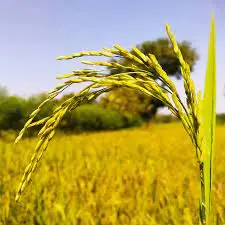No products in the cart.
Understanding the Rice Crop: Types, Cultivation, and Global Impact
The Complete Guide to Understanding the Rice Crop
Rice is not just a staple food but a cultural icon across the globe. Let’s delve into the fascinating world of rice crop cultivation, its varieties, cultivation practices, and much more.

Table of Contents
| Sr# | Headings |
|---|---|
| 1 | Introduction to Rice Crop |
| 2 | History of rice crop Cultivation |
| 3 | Major Varieties of rice crop |
| 4 | rice crop Growing Conditions |
| 5 | Steps in rice crop Cultivation |
| 6 | Pests and Diseases in rice crop |
| 7 | Harvesting and Processing |
| 8 | Global Importance of Rice |
| 9 | Nutritional Value of Rice |
| 10 | Environmental Impact of Rice Farming |
| 11 | Future Trends in Rice Production |
| 12 | Conclusion |
1. Introduction to Rice Crop
Rice, the staple food for over half of the world’s population, is a versatile and indispensable crop. Its cultivation dates back thousands of years and has shaped cultures and economies globally.
2. History of Rice Cultivation
Rice cultivation has ancient origins, with evidence suggesting it was first domesticated in China around 10,000 years ago. From there, rice farming spread across Asia and later to other parts of the world.
3. Major Varieties of Rice
Types of Rice
Rice comes in many varieties, broadly categorized into long-grain, medium-grain, and short-grain types. Each type has distinct characteristics suited for different culinary purposes.
Popular Varieties
- Basmati Rice: Known for its fragrance and elongated grains, often used in Indian and Middle Eastern cuisines.
- Jasmine Rice: Aromatic and slightly sticky, popular in Southeast Asian dishes.
- Arborio Rice: Short-grain rice, ideal for creamy Italian risottos.
4. Rice Growing Conditions
Climate Requirements
Rice thrives in warm climates with high humidity and plenty of water. It is predominantly grown in flooded fields known as paddies.
Soil Requirements
Rice requires fertile, clayey soil with good water-retaining capacity. It also benefits from soil that is slightly acidic.
5. Steps in Rice Cultivation
Planting
Rice is usually started in a nursery and then transplanted into flooded fields.
Fertilization
Proper fertilization is crucial, typically involving nitrogen-rich compounds to enhance growth.
Water Management
Maintaining proper water levels in the fields is essential throughout the growing season.
6. Pests and Diseases in Rice
Common Pests
- Rice Blast: Fungal disease affecting leaves and grains.
- Brown Planthopper: Insect that feeds on rice stems, affecting growth.
Preventive Measures
Integrated pest management and resistant varieties are used to control pests and diseases.
7. Harvesting and Processing
Harvesting
Rice is harvested using either manual or mechanized methods, depending on the scale of cultivation.
Processing
The harvested rice undergoes milling, where husks are removed to produce edible rice.
8. Global Importance of Rice
Cultural Significance
Rice plays a central role in the cuisines and cultures of many countries, particularly in Asia.
Economic Impact
Rice cultivation supports millions of farmers and is a significant export commodity for many nations.
9. Nutritional Value of Rice
Nutrients
Rice is rich in carbohydrates, providing essential energy, and also contains small amounts of protein and vitamins.
Dietary Considerations
It is gluten-free and suitable for those with celiac disease or gluten intolerance.
10. Environmental Impact of Rice Farming
Water Use
Rice paddies can be water-intensive, impacting local water resources.
Methane Emissions
Flooded rice paddies can contribute to methane emissions, a potent greenhouse gas.
11. Future Trends in Rice Production
Technological Advancements
Advances in genetics and farming techniques aim to increase yield and reduce environmental impact.
Sustainable Practices
There is a growing focus on sustainable rice farming practices to minimize environmental footprint.
12. Conclusion
Rice is more than just a food staple; it’s a crop deeply intertwined with human culture and history. Understanding its cultivation and significance enriches our appreciation for this essential grain.
Frequently Asked Questions (FAQs)
What are the different types of rice?
There are various types such as Basmati, Jasmine, and Arborio, each with unique qualities suited for different cuisines.
How is rice harvested?
Rice is harvested either manually or using mechanized equipment, depending on the scale of farming.
Is rice cultivation environmentally friendly?
While rice cultivation can have environmental impacts, sustainable practices are being developed to mitigate these effects.
What are the nutritional benefits of rice?
Rice is rich in carbohydrates and provides essential nutrients like vitamins and minerals.
Where is rice grown the most?
Rice is predominantly grown in Asia, with China and India being the largest producers.
Go and turn on towards organic farming to save future and thire save childs:
Elevate Plant Growth with Premium Bone Powder – Buy Now!
Organic Cow Dung Compost: Transform Your Garden Naturally
Premium Humic Acid for Healthy Plants | Enhance Soil & Boost Growth
Boost Plant Growth Naturally with Mustard Cake | Organic Fertilizer
Transform Your Garden with NPK Fertilizer | Boost Growth by 30%
Premium Perlite for Enhanced Gardening | Buy Now
Live Earthworms with Enhance Your Garden (soil health)
1 Neem Khali: Unveiling the Wonders of Nature
1Transform your garden with vermiwash-buy now
1 Premium quality Vermicompost [ केचुआ खाद ]
Follow us:
Tagged Inrice crop



